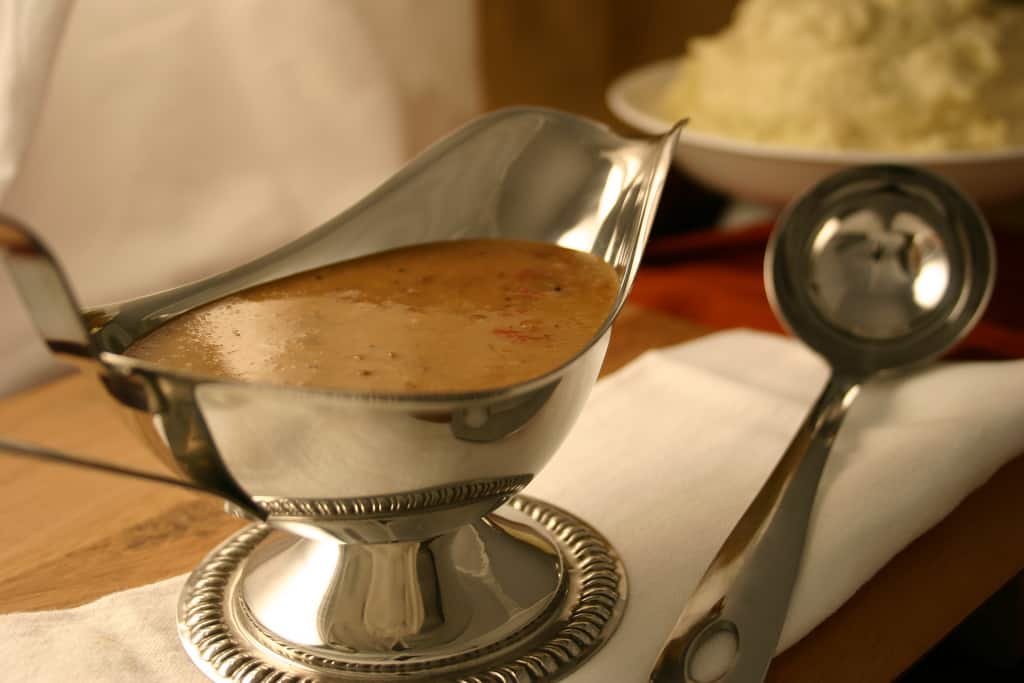
Photo: Glory Foods / Flickr
Gravy’s importance is often overlooked in British cooking, though a fine meal can be completely ruined by a bad gravy. On the other hand, a good gravy recipe can completely elevate even an average dinner, ready in under 30 minutes.
Traditionally made from the juices of meats that run naturally during cooking, gravy is presumed to come from the term ‘gravé’, found in numerous Medieval French cookbooks, though using it as a sauce is believed to date back to antiquity. As the French began to focus on sophisticating sauces in more recent years, gravy – as it’s known today – has become popular in many countries over the world, so much so that countless companies have begun to manufacture products to help people make quick, easy, often instant gravy at home. Introduced during the early 20th century, products such as Bisto were met with huge popularity, still a larder staple in thousands of households. Although amiably convenient, instant gravy’s flavour doesn’t come close to the real thing.
To make the best gravy at home, it’s necessary to follow a series of crucial steps, making sure that each is executed perfectly before moving on to the next process. Timing here is key, as are the correct ingredients. Onions are essential, as is stock and – ideally – something acidic such as wine or a splash of Balsamic vinegar. Some optional extras can also be added, and although not completely necessary, they’re highly recommended for making the best possible gravy. Adding other vegetables such as celery, leek, or carrot; using homemade stock; adding a generous splash of soy and/or Worcestershire sauce. At its most basic, this recipe will produce a delicious sauce, but I like to think of a point scheme where each optional step adds a proverbial point to the flavour of your final result.
Pairing flavours is also important. While the base steps remain the same for almost any gravy recipe, it’s worth noting that certain dishes are more suited to different iterations of the sauce. Onion gravy should ideally be made with beef stock (or a vegetarian alternative) and a dash of Balsamic, while it’s worth utilising mushroom stocks to amplify the flavour of vegetarian dishes. The ideal foundations for each are as follows:
Poultry/chicken gravy recipe: base vegetables, thyme, chicken stock, white wine.
Beef/veal/lamb gravy recipe: base vegetables, thyme, beef/veal/lamb stock, red wine.
Pork gravy recipe: base vegetables, sage, chicken stock, cider.
Onion gravy recipe: onions, thyme or rosemary, beef stock (or vegetarian alternative), Balsamic vinegar.
Vegetable gravy recipe: base vegetables, thyme or rosemary, mushrooms, mushroom/vegetable stock, red/white wine.
Each follows a simple process of sautéing the base vegetables, adding the chopped herbs and garlic, adding the wine or vinegar and cooking until reduced, adding the stock and simmering until the desired consistency is reached. Simple.
And while each cooking process should be followed exactly, the recipe does encourage adaptation with additional ingredients. Fancy stirring some cranberry sauce into your chicken/turkey gravy? Go for it. Making it to serve with fried chicken? Save those fried breadcrumbs from the oil and add to the gravy to intensify the flavour. Can’t be bothered to strain? Chop the vegetables slightly coarser and cook for longer before adding liquid.
It’s also delicious the next day, warmed and served with leftovers or as a sauce in sandwiches. The possibilities are absolutely endless, though granules are strictly prohibited.